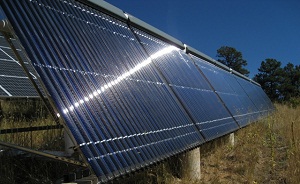Solar companies experiencing rough patch
 As solar power moves beyond a nom du jour and takes its place among the world’s important sources of electricity, the companies that make solar technologies are experiencing growing pains.
As solar power moves beyond a nom du jour and takes its place among the world’s important sources of electricity, the companies that make solar technologies are experiencing growing pains.
None illustrate this more than Solyndra, which recently said it would lay off workers even as it ramps up production at its new facility.
Industry analysts and insiders said that as the solar market really takes off there will likely be more industry consolidation, company restructuring and some failures.
Solyndra produces cylindrical copper indium germanium diselenide (CIGS) PV modules. The company came to the media’s attention when it became the first PV company to receive a loan guarantee through the U.S. Department of Energy. The $535 million loan guarantee was primarily used to build Fab 2, its second production facility, said Solyndra spokesperson David Miller.
The company’s growth has fizzled somewhat.
The company originally planned to keep both its original plant—Fab 1—and the new plant open. But in November 2010, Solyndra announced that it would close Fab 1, reduce its payroll by 24 to 40 employees and won’t renew contracts for 135 temporary workers.
And earlier this year, Solyndra cancelled its initial public offering. That’s partly because of price drops in silicon and increased competition from China.
“From late 2008 from 2009 you had this crash in silicon prices and a very low demand in 2009. Companies had ramped capacity too much,” said Johanna Schmidtke, Ph.D., Senior Analyst with Lux Research. “What some of the Chinese firms did was to really be able to sell low, cut their prices and get materials into major markets and start to build market share. And that’s helped them to come out of the recession and build a name for themselves.”
She explained that by taking a short-term expense, they have become some of the most important players in the solar market.
“With China already producing more than 50 percent of the world’s PV supply, and most companies in China aiming to expand their market share in 2011, it’s not easy [to compete] for sure,” said Pavel Molchanov, Raymond James vice president and equity research analyst. “Certainly, there are companies that are able to compete, like First Solar. But for high-cost producers [companies like Evergreen Solar] it’s a nightmare.”
The decline in silicon price was something a lot of companies had to deal with, Miller said.
“When we started, price-per-watt was at a much higher level,” he said. “About a year ago people were thinking $4 per watt was going to be competitive, and it’s dropped dramatically since then.”
He added that Solyndra now is closer to $3 per watt in terms of PV costs.
However, Monique Hanis, spokesperson of the Solar Energy Industries Association, observed that trade flow is going both ways between China and the U.S.
“The U.S. is a big exporter,” she said. “I see a growing market in the U.S. and U.S. companies growing with it.”
Story continues here.
Pictured: An example of cylindrical solar panels, which are similar to the ones Solyndra manufactures. Photo: Meehan.



